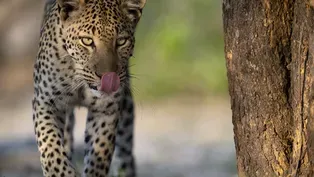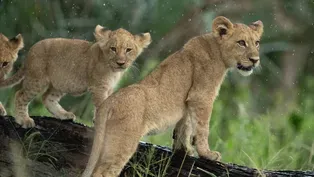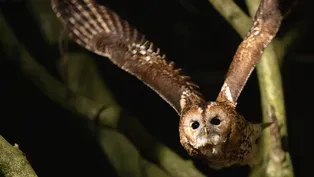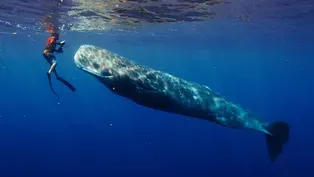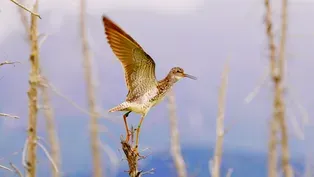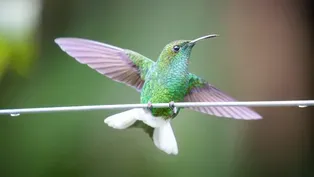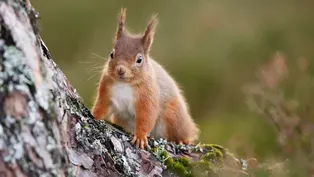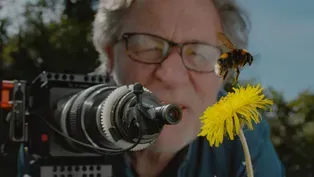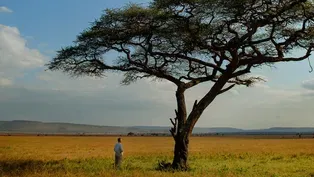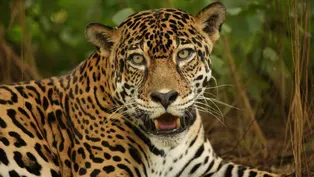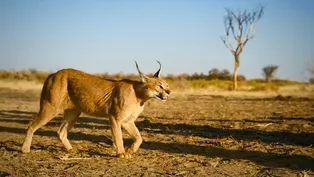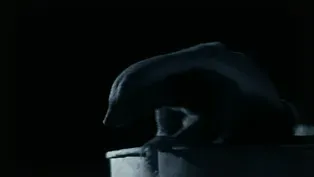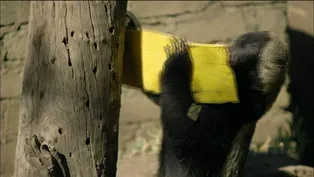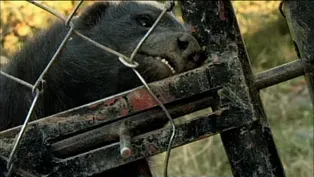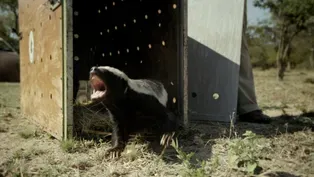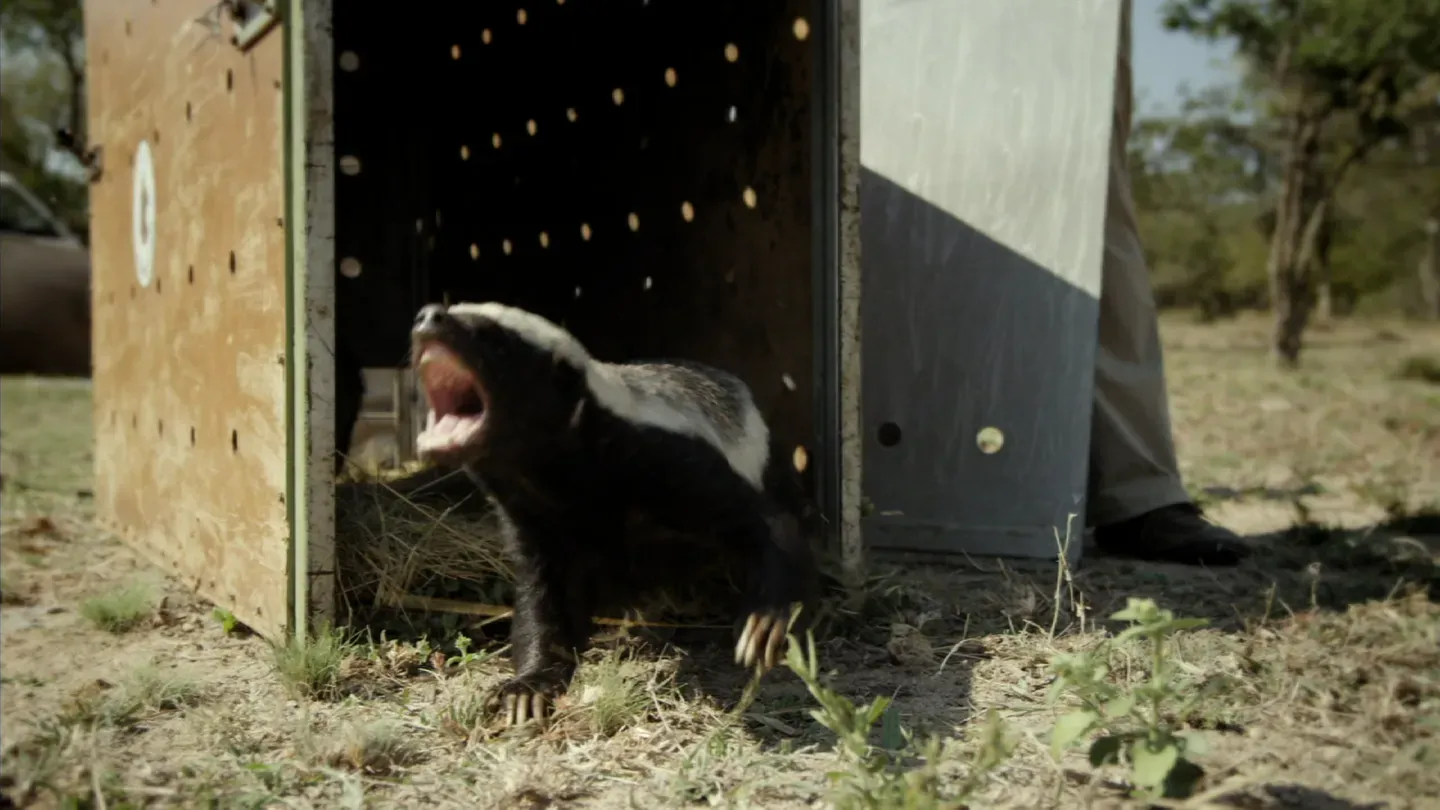

Honey Badgers: Masters of Mayhem
Season 32 Episode 12 | 52m 58sVideo has Closed Captions
Nature follows one of the most fearless animals in the world: the honey badger.
“Honey badger is bad ass.” Those words and corresponding video became a YouTube sensation with 51 million hits. This relentless little creature is renowned for its ability to confront grown lions, castrate charging buffalo, and shrug off the toxic defenses of stinging bees, scorpions, and snakes. Little is known about its behavior in the wild or why it is so aggressive.
Major support for NATURE is provided by The Arnhold Family in memory of Henry and Clarisse Arnhold, The Fairweather Foundation, Sue and Edgar Wachenheim III, Kate W. Cassidy Foundation, Kathy...

Honey Badgers: Masters of Mayhem
Season 32 Episode 12 | 52m 58sVideo has Closed Captions
“Honey badger is bad ass.” Those words and corresponding video became a YouTube sensation with 51 million hits. This relentless little creature is renowned for its ability to confront grown lions, castrate charging buffalo, and shrug off the toxic defenses of stinging bees, scorpions, and snakes. Little is known about its behavior in the wild or why it is so aggressive.
How to Watch Nature
Nature is available to stream on pbs.org and the free PBS App, available on iPhone, Apple TV, Android TV, Android smartphones, Amazon Fire TV, Amazon Fire Tablet, Roku, Samsung Smart TV, and Vizio.
Buy Now

Explore More Ways to Watch
Bring the beauty and wonders of wildlife and natural history into your home with classic NATURE episodes.Providing Support for PBS.org
Learn Moreabout PBS online sponsorshipMore from This Collection
Outlanders | Big Cats, Small World
Video has Audio Description, Closed Captions
The change of seasons brings turmoil and tough choices to the three big cat families. (53m 33s)
Landlords | Big Cats, Small World
Video has Audio Description, Closed Captions
Lion, leopard and cheetah parents attempt to co-exist and raise their cubs in Botswana. (53m 33s)
Extreme Lives | Raptors: A Fistful of Daggers
Video has Audio Description, Closed Captions
See the extreme ways in which raptors conquer the toughest habitats on Earth. (53m 28s)
Video has Audio Description, Closed Captions
Patrick Dykstra has a life-changing encounter with a sperm whale and uncovers their world. (53m 8s)
Video has Audio Description, Closed Captions
Follow scientists racing against the clock to save the world’s migratory shorebirds. (53m 18s)
Video has Audio Description, Closed Captions
A Caribbean coral reef discovery marks a new chapter in understanding and saving corals. (53m 18s)
Video has Audio Description, Closed Captions
Discover the powerful effect hummingbirds have over their wild neighbors in Costa Rica. (53m 13s)
Video has Audio Description, Closed Captions
Immerse yourself in Scotland with its magnificent 500-year-old Scots pine tree. (53m 18s)
Video has Audio Description, Closed Captions
Discover the diverse species and personalities of bees who live in a British urban garden. (53m 13s)
Video has Closed Captions
Meet the pioneering group of scientists who transformed our understanding of ecology. (53m 13s)
The Story of Cats | Into the Americas
Video has Closed Captions
Discover how cats first crossed from Asia into North America and became the top predators. (52m 58s)
The Story of Cats | Asia to Africa
Video has Closed Captions
Discover how the first cats arose in the forests of Asia and later came to conquer Africa. (53m 29s)
Providing Support for PBS.org
Learn Moreabout PBS online sponsorshipNARRATOR: Out on the African plains, even the king of beasts makes way for one relentless little warrior.
Meet the savannah's true tough guy, the honey badger.
Known to be absolutely fearless, honey badgers never give up, never give in.
MAN: The honey badger to me is so brave and so courageous and so determined that you can't help but love him.
NARRATOR: But he's simply impossible to live with.
MAN: The first honey badger I took in was Stoffel.
He caused chaos in the house.
I mean, he'd come and break through the window, go to the kitchen, kick the fridge open.
And you don't dare stop him.
NARRATOR: And trying to follow honey badgers out in the bush isn't any easier.
MAN: It's actually quite frustrating.
I see these animals literally every single night.
They come in, cause chaos inside camp.
As soon as morning hits, they just disappear.
NARRATOR: But instead of courage or ferocity, their sharpest weapon might just be one of the best brains in all the wild.
MAN: Stoffel!
NARRATOR: In South Africa's Limpopo Province, zoologist Low de Vries is on the trail of a pint-sized animal with a massive reputation.
LOW: I've been fascinated by these guys from a very young age, from eight, nine years old.
In Afrikaans, we say, "Su teis as a ratel," which means, "As tough as a honey badger."
That's what I love -- I love that attitude.
Low is keen to get beyond the legend and find out what the honey badger is really like.
For a start, it isn't really a badger at all.
It's a souped-up weasel, built for strength and stamina.
Though reasonably common, honey badgers are mostly nocturnal and rarely seen.
They're still relatively unknown to science.
Even their special ability to sleep off snake bites and wake up unharmed remains a mystery.
Up to a quarter of their diet is made up of venomous snakes.
Nor do we know why the young stay with their mothers for so long -- nearly twice as long as true badgers.
But it's tales of the honey badger's sheer audacity that have become the stuff of legend.
LOW: There's all these myths about them.
How many of those are true?
STERN: Following a tip off, Low and his field assistant Becky are heading to a safari lodge where these normally elusive animals are reported to be turning up every night.
Tucked away on the outskirts of Kruger National Park, the lodge could be the perfect place for Low to set up a new research project.
Honey badgers are scavengers as well as hunters.
At the safari lodge, they've learned there's a regular supply of leftovers at the rubbish dump.
According to maintenance manager Alfred, the dump has become a magnet not just for badgers, but for other animals, too.
[Alfred speaking English] -LOW: Oh, with hyena?
-Yeah.
LOW: Have you seen them fight here?
-ALFRED: Yeah.
-What happens when they fight?
[Low speaking English] STERN: It might not be pretty, but the rubbish dump offers Low the perfect opportunity to see where honey badgers rank in the pecking order.
LOW: So, this is where you dump all the rubbish then?
STERN: Can a badger, as Alfred claims, actually face off an animal five times its own weight?
LOW: From which direction do they normally come?
LOW: Ah, this little trail here?
LOW: So, what time do they normally come in?
LOW: Okay.
Thank you very much, Alfred.
Appreciate it.
STERN: Low will be back at dusk to see for himself if the honey badger really is top dog.
Though badgers are tolerated at the lodge, they can be a persistent problem for local farmers.
MAN: I'm trying to make a living out of free-range pigs.
Around me is the "big five," but my problem is not the big five.
The real problem is the honey badger.
That's the big problem.
STERN: As well as raiding his pig food, badgers have attacked and even killed his dogs.
MAN: A week ago I catch two in one night.
They do a lot of damage.
STERN: Some farmers just shoot the badgers.
This one's lucky to be getting a second chance.
The farmer has called in Brian Jones, a wildlife conservationist with a soft spot for honey badgers.
It's wonderful that you're prepared to save the animals like this.
FARMER: They're after the food of my pigs.
JONES: Okay, open up.
Give it to me.
STERN: Brian looks after all kinds of unwanted animals, and yet despite its rough reputation, the honey badger is his favorite.
He's rescued around 50 so far.
FARMER: Okay, Brian, thank you very much.
Bai danke.
Go well.
STERN: The badger will be set free later, as far away from the farmer as possible.
JONES: They do get hurt in their traps.
If we see it's quite serious we will treat them accordingly.
When that's healed we let them go again.
Hopefully they don't go back to that man, because that man might now decide to start killing them.
STERN: Brian is heading back to base, to the place that's been his home for the last 22 years.
Set in its own 1,200-acre game reserve, Moholoholo is a privately-run animal rehabilitation center.
As well as providing a temporary refuge for injured wildlife, it also houses a few longer-term residents, including a honey badger called Stoffel, and his girlfriend, Hammy.
JONES: I've had in my house hippo, rhino, brown hyena, spotted hyena, leopards, cheetah, lion.
I've had the whole lot.
But the honey badger -- there's nothing near the honey badger.
The first honey badger I took in was Stoffel.
He caused chaos in the house.
He damaged everything.
I mean, he'd come and break through the window, go into the kitchen...
Knock the dog biscuits over, go to the fridge, lie on his back, kick the fridge open... Go and smell what's on the menu today... Get the frozen bacon, sit on his back and eat it.
And you don't dare stop him.
You just let him do what he wants.
WOMAN: Stoffel!
Stoffel!
Come on, let's go!
I don't believe it.
STERN: Stoffel came here 20 years ago as someone else's unwanted pet, not fit for release into the wild.
Though happy at first to look after him, Brian soon discovered that the badger was a menace to his other animals.
[Jones] He grabbed the rhino from underneath and wouldn't let go.
And the rhino -- [Squealing] He grabbed one of my tawny eagles.
He killed the servals.
He wiped out 30, 40 guinea pigs, one shot.
He was extremely destructive.
When he flies into you, it's not a joke.
He really rips you to pieces.
STERN: Stoffel was becoming the pet from hell.
Stoffel!
Come on, my boy!
Stoffel!
STERN: Alas for Brian, this was just the start of a long and challenging relationship.
Honey badgers, as their name suggests, are fond of honey.
But the mayhem they cause trying to get it makes them a scourge to beekeepers.
MAN: I've spoken to some of the beekeepers in this area who've lost up to 60 hives in one night.
If you consider that a beehive costs about 1,000 rand, and takes about two or three years to develop into a production colony, you can see what the loss is, it's huge.
STERN: On the other hand, it takes guts to face an angry swarm.
Badgers that get it wrong have been stung to death.
It's the protein-rich grubs they're after, as much as the honey.
MAN: I've seen some hives where the badger's actually got in from the side and chewed through this 22 millimeter wood.
22 mil is about that thick.
Solid pine -- you know, it's ripped apart.
Decimation!
Badger won't stop at anything.
[Laughs] STERN: Sadly, badgers that raid too often risk being poisoned.
Guy Stubbs wants to protect honey badgers from the wrath of his fellow beekeepers by developing a cheap but effective badger-proof hive.
He's come to the rehab center, where he's eager to try out his approach on some real badgers.
Phase One is all about watching and learning.
MAN: Jan, please release the badgers.
STERN: Enter test badger Stoffel, and his apprentice, Hammy.
Badgers are adept at scaling trees, but Guy thinks they'll struggle to reach the hive if there's no bark to grip onto.
GUY: Okay, you can see, he's actually just using one claw at a time, and he's hooking his claw into any little crevice and hole that he can find.
And then he pulls his whole body up.
So, it's showing incredible strength.
[Badger grunting] GUY: Can you hear that panting?
It sounds like it's a lot of effort for him.
STERN: Through sheer determination, Stoffel eventually gets within range.
GUY: Look at the way that he's grabbing onto that plastic... And is actually ripping pieces of it off.
STERN: The sweet taste of success!
With all his footholds figured out, Stoffel is soon back up to finish the job.
A few painful stings is a small price to pay.
One honey badger was found alive with well over 300 stings.
GUY: So, by just having it off the ground, in a tree, isn't a guarantee for protecting your hive.
STERN: Armed with valuable first-hand observations, Guy is now ready to go and design his badger-saving, badger-proof hive.
At the game lodge near Kruger National Park, zoologist Low de Vries has a ring-side seat at the rubbish dump.
He's hoping to see for himself if the honey badger lives up to its ferocious billing.
There's no mistaking a honey badger.
It wears a bold black-and-white coat and moves with a confident trot.
STERN: Like a skunk, its vibrant markings send a warning -- "Mess with me at your peril."
STERN: The two badgers certainly don't appear put off by Low's presence.
Pairs of badgers were once thought to be couples.
But in fact, badger pups stick with their mothers for up to two years, and it can be hard to tell one from the other.
[Low whispering] STERN: A long childhood suggests the pup has a lot to learn before it can survive on its own.
This one is busy mastering the art of bin raiding.
[Low chuckles] STERN: The greedy badgers won't have the place to themselves for long, and they seem to know it.
Porcupines are the next to show up.
Along with the jackals, they hang around to wait for the badgers' discarded scraps.
If push comes to shove, it becomes clear who's boss.
Even the civet, a larger carnivore, moves on.
For Low, this is a rare opportunity to watch wild honey badgers.
The action at the bins might compare to what happens at a carcass.
LOW: I'm noticing the incredible number of sounds these guys are making... Chattering, growling at each other.
Growling at the other animals, chirping away, kind of like a contact call.
At times they almost sound like jackals.
They are not bothered by my presence.
I've been obsessed with these animals for so many years.
STERN: Honey badgers normally forage alone, but news of the dump appears to have spread.
With fresh arrivals, there are soon more badgers than bins.
And now they must contend with each other.
[Badgers growling, snarling] [Laughing] LOW: Silly badgers!
[Chuckles] STERN: Over at the lodge, another gang of gate-crashers is piling in.
Remote cameras reveal them making a beeline for the kitchen.
The masters of mayhem have arrived.
[Glass breaking] Back at the bins, things have taken a serious turn.
With jaws nearly twice as strong as a lion's, a spotted hyena could crush a badger with a single bite.
[Low whispering] It's backing off.
STERN: The cause of the hyena's hasty retreat soon becomes suffocatingly apparent.
Ugh!
Oh, my word!
That's horrible!
STERN: One of the badgers, it seems, has deployed a concealed weapon.
Oh, that's bad!
STERN: Fluid ejected from the badger's anal pouch can be smelled from 40 yards away.
Ugh, that's truly awful!
This actually makes your eyes water.
I've no idea how they live with themselves.
STERN: At the rehab center, Brian Jones was soon learning from his pet badger, Stoffel, that the animal's reputation for bravery was no myth.
[Jones] STERN: In one incident in the wild, honey badgers are said to have chased seven lions from their kill.
For Stoffel, though, fighting alone, round two was a disaster.
JONES: He did it again.
But this time he didn't get off so well.
They pulverized him a bit.
He was in the hospital two and a half months.
STERN: Though Stoffel survived, honey badgers are not invincible.
Because of their sometimes foolhardy bravado, they are occasionally mauled to death by big cats.
After his close encounter with badgers at the dump, Low is keen to get deeper into their world.
The whole question of why pups hang around with their mothers for so long is intriguing him.
Local tracker Enoch says he's spotted a mother and baby using an old termite mound as a den, less than a mile from camp.
It could be the breakthrough that Low needs.
Despite their small size, honey badgers travel huge distances in search of food.
With their incredible stamina, they're easily capable of moving 20 miles a night, which makes them hard to pin down.
But if there's one badger that's likely to stay put, it's a nursing mother near a regular source of food.
LOW: So, is this the hole where you saw the honey badger with the pup?
ENOCH: Yeah, this is the one.
[Enoch] STERN: Low decides to put the burrow under surveillance.
With a bit of luck, the mother and pup will give him a unique window into the normally hidden world of badger parenting.
After Stoffel's severe mauling by the lions, Brian knew that he had to get his badger under control.
His solution was a brand new pen... and the introduction of Hammy, to help him work off steam.
Far from settling down, though, the canoodling couple soon proved that honey badgers are not just fearless, they're astonishingly clever.
JONES: We started off with a mesh-type fence, but it didn't work.
Stoffel soon devised a plan for opening up the gate, which has got two bolts.
He would get the female to go up.
She would go up, open the first gate, and he'd hold the gate and say, "Woman, get up!
I'm pulling open, you open up."
She goes up to the top, she pulls the second one out.
And then he pulls it open, he waits for her to get down, and they escape together.
STERN: The escape was no fluke.
Considering their small size, honey badgers have remarkably big brains.
Their intelligence is just beyond anything.
STERN: Whatever Brian did to keep him in, Stoffel was hell-bent on getting out.
In the end, and at great expense, Brian had no choice but to build his own "Badger Alcatraz."
JONES: I said, "Stoffel, the days of your escape are over, buddy."
Uh-huh.
That night they call me -- "Brian, Stoffel's out!"
I say, "It's impossible!"
But we had trees in here, and he'd climb up the trees and lean over onto the wall, and he was out.
So, we cut all the branches out of the trees in here, and left the trees in the middle.
Next afternoon, here's Stoffel back in the office to come and greet me.
Said, "How did he get out?!"
We came here, and the trees left in the middle, he spent the whole night bending the branch, bending the branch, twisting until it broke, he puts it on his back, Then he carries it to the wall, leans it against the wall with his back feet, and climbed out, and that's how he got out.
And we had to take all the trees out.
Then he dug up the rocks, and he'd roll them with his back feet to the wall, until he piled them up high enough.
And then he'd get out.
So, we took all the rocks away.
This was like a game for Stoffel.
Every time I devised some plan, it was like a game for him to work out, how could he get over this.
[Glass breaking] 1:00 in the morning, my wife wakes me up, "Brian, Brian, someone's in the house."
She said, "I heard a window break."
So we freeze.
[Thud] "Oh, my!"
Expecting burglars.
And here's Stoffel at my bedroom door, trying to get through the bedroom door.
He made himself a mud ball, and he'd pat it to make it bigger, and he rolled it, and he stands on it and he just got up like that.
People have said, "Oh, did you train?"
I say, "Train it?
Not at all!
Didn't even think of it!"
He outwitted us each time, with his schemes.
Stoffel!
JONES: I remember one day, keeper left a rake in Stoffel's enclosure.
He scratched himself, lies on his side -- now, he's thinking -- computer's working.
"Take the rake, put it on his back, put it against the wall."
Climb out, and off he goes.
MAN: Stoffel!
I mean, you won't believe these stories!
You think it's a hoax.
It's not a hoax.
That is Stoffel.
STERN: On the outskirts of Kruger National Park, Low has the badger's den under surveillance.
The photos from the first night, however, reveal an unexpected visitor.
LOW: Leopard on the camera trap at twenty to 6:00.
Twenty to 6:00 -- that's ten minutes after I placed the trap out.
STERN: It's not a good sign.
Leopards are one of the very few animals known to kill honey badgers.
LOW: Unfortunately, there are no honey badgers on these shots, which is kind of strange.
I saw the tracks there with my own eyes.
Enoch said those tracks were relatively fresh.
Either this was never a den and the honey badgers just kind of came through, or the mother felt threatened by the presence of the leopard there and decided to move the pup.
STERN: Perhaps the average wild honey badger is smart enough to know its limits.
The mother's vanishing act leaves Low back at square one.
The difficulty in finding and tracking badgers in the wild is a major problem for anyone who wants to study them.
Having lost a promising lead, Low decides to try an experiment.
LOW: There is this one intriguing story that a bird called the honeyguide takes honey badgers to bee nests.
The honey badger goes and breaks open the nest, and honeyguides can then feed on the honey.
STERN: It's known that honeyguides will lead humans to bees' nests, but it's never been shown for honey badgers.
LOW: I think it might be true.
If they've been shown to lead in humans, why not honey badgers?
There's no reason why it shouldn't be true.
STERN: Using a recording of the greater honeyguide, Low is hoping to lure a badger out of its burrow.
[Birdcall playing] But after several hours and many miles, the jury is still out.
Not a single badger has come out of its hole.
Over at the rehab center, beekeeper Guy Stubbs is finally ready to pit his wits against Stoffel and Hammy, with what he hopes is a badger-proof hivestand.
GUY: The important thing is to make sure that you leave nothing lying around that Stoffel can use as a tool to climb onto the stand.
STERN: With room for up to ten hives, Guy's raised metal cage is quick to assemble.
If it works, it'll help keep the peace between beekeepers and badgers.
GUY: Okay, I think everything's ready now.
Jan, won't you release the badgers, please?
I feel that we've got a good chance.
I don't think they can get up here.
There's Stoffel trying.
Look at that.
Looks a bit like a sloth.
He's feeling for a little hole or a grip, like he did with the tree, but he's not finding one.
They're too slippery.
This is how we stop them getting in.
STERN: Hammy has been watching from the sidelines, and with Stoffel flagging, she moves in.
GUY: Can you see?
Can you see her claws?
She seems to be getting a grip!
Oh, this is terrible.
No!
Ugh, no, man!
And there she's got it!
She's got onto the hive.
Can you believe it?
Ugh!
[Chuckles] She's actually pushed her way through and got to the honey that way.
That's her technique now.
She's pushing the hives all over the place -- and now she's blocked my view.
Well, this is unfortunately not even Stoffel.
It's even more embarrassing.
STERN: It's round one to Hammy... And back to the drawing board for Guy.
[Camera shutter clicking] GUY: I've tried everything.
I've got a lot of respect for honey badgers.
STERN: Out in the bush, another day is drawing to a close.
And the night shift is beginning to stir.
For three weeks, Low and his field assistant, Becky, have been searching for badgers beyond the camp, without success.
But they're about to get lucky.
BECKY: Where is he?
STERN: They've staked out a spot with fresh signs of badger activity, and it's paid off.
Two badgers, a mother and a large male pup, have returned to dig up more food.
Most likely, they're after beetle grubs or scorpions.
[Low] STERN: The two badgers are soon joined by a third.
It's a huge male -- and he's not interested in dinner.
[Low] STERN: He seems to sense that the female is ready to mate again, after nearly two years of single parenting.
When a mother starts to entertain suitors, it's the cue for her pup to move on and strike out on its own.
This is potentially a big night for him.
For Low and Becky, it's a rare and unexpected chance to observe courtship, honey badger style.
[Becky] [Female squawking] [Becky and Low laughing] [Becky] [Becky] [Low] [Becky] [Low] [Low] [Becky] STERN: Taking the hint, perhaps, the younger male moves off to feed elsewhere, leaving the lovers to themselves.
But the newly independent badger could hardly have picked a worse night to go solo.
He's dangerously isolated, and his mother is too wrapped up to notice the old enemy is back.
This time, the hyenas have turned up in force -- and the young male is out in the open.
Whatever food the badgers have sniffed out, the hyenas now want to claim for themselves.
Retreat would seem to be the sensible option here.
[Hyenas calling] Incredibly, though, the young male stands his ground, as if daring the hyena to attack.
[Growling] Meanwhile, the big male has at last cottoned on, and immediately squares up for a fight.
Mother seems happy to let the boys sort it out.
STERN: The four hyenas are determined to muscle in, but the outnumbered badgers are equally determined to force them back.
[Snarling] STERN: The honey badgers aren't bluffing.
They're quite possibly the bravest act in the African bush.
Some would say they're also the smartest.
Having been outwitted by Stoffel countless times, Brian isn't taking any more chances.
Reluctantly, he's had to add an electric fence to the badger's pen.
It's for everyone's benefit...
Including Brian's.
JONES: I've tried to make peace with him, but he just wants to kill me.
Whenever he hears my voice, his tail's up, ready for attack.
[Laughs] Hello, Stoffel.
Hello, my baby.
Yes, my buddy.
Oh, Stoffel!
Hey!
Stoffel!
Don't you forgive me?
Oh, Stoffel, you're worse than a woman -- you just don't forget.
STERN: Aside from looking after Stoffel, the business of saving wild badgers is keeping Brian as busy as ever.
Three more animals trapped by farmers have now been patched up and are ready for release.
Brian can only hope that the badgers don't go and create havoc for someone else.
JONES: He's looking to see if we're following him.
And he's got the cheek to growl on the way.
Ach, you lovely thing.
STERN: One gone, two more to launch.
Brian knows that these badgers won't be the last he saves.
But he'll keep doing whatever it takes to give these relentless little warriors a chance.
JONES: The honey badger to me is so brave and so courageous and so determined that you can't help but love him.
He's really got a place in my heart.
STERN: After a month at the safari lodge trying to track honey badgers in the wild, Low is stumped.
He's seen for himself the honey badger's reputation for courage and ferocity isn't just hype, yet as a scientist he still has so many questions he wants to answer.
LOW: It's actually quite frustrating at the moment.
I see these animals literally every single night.
They come in, cause chaos inside camp... As soon as morning hits, they just disappear.
STERN: Their fearlessness is backed up by a more subtle quality that enables them to get just what they want -- and then vanish.
Perhaps intelligence is what really gives the honey badger its edge.
But has Stoffel, that cunning little mastermind, finally been defeated?
Or has Brian Jones merely set the stage for his most ingenious escape yet?
After all, honey badgers never give up.
To learn more about what you've seen on this "Nature" program, visit pbs.org.
Trailer: Honey Badgers: Masters of Mayhem
Nature follows one of the most fearless animals in the world: the honey badger. (49s)
Providing Support for PBS.org
Learn Moreabout PBS online sponsorshipMajor support for NATURE is provided by The Arnhold Family in memory of Henry and Clarisse Arnhold, The Fairweather Foundation, Sue and Edgar Wachenheim III, Kate W. Cassidy Foundation, Kathy...
